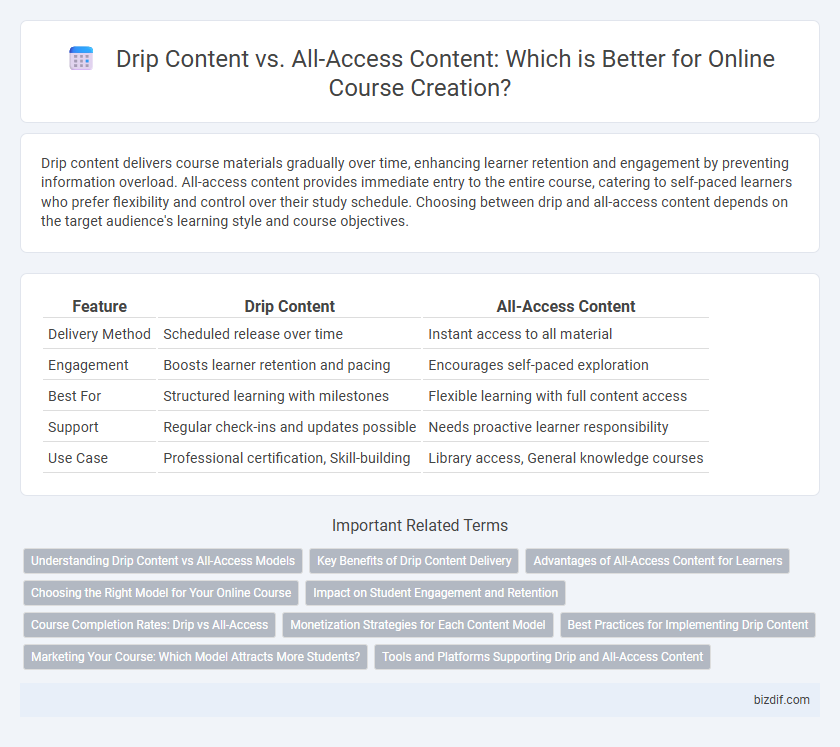Drip content delivers course materials gradually over time, enhancing learner retention and engagement by preventing information overload. All-access content provides immediate entry to the entire course, catering to self-paced learners who prefer flexibility and control over their study schedule. Choosing between drip and all-access content depends on the target audience's learning style and course objectives.
Table of Comparison
| Feature | Drip Content | All-Access Content |
|---|---|---|
| Delivery Method | Scheduled release over time | Instant access to all material |
| Engagement | Boosts learner retention and pacing | Encourages self-paced exploration |
| Best For | Structured learning with milestones | Flexible learning with full content access |
| Support | Regular check-ins and updates possible | Needs proactive learner responsibility |
| Use Case | Professional certification, Skill-building | Library access, General knowledge courses |
Understanding Drip Content vs All-Access Models
Drip content delivers online course material incrementally over a set schedule, enhancing learner engagement and reducing overwhelm by pacing content consumption. In contrast, all-access content offers students immediate, unrestricted entry to all course modules, facilitating flexible, self-paced learning. Choosing between drip and all-access models depends on course objectives, learner preferences, and desired retention outcomes.
Key Benefits of Drip Content Delivery
Drip content delivery enhances learner engagement by providing materials in manageable, timed intervals, which promotes better retention and minimizes overwhelm. This approach facilitates structured progression through a course, encouraging consistent study habits and reducing dropout rates. Additionally, drip content allows instructors to strategically align lessons with learner readiness, optimizing the educational impact and fostering long-term knowledge retention.
Advantages of All-Access Content for Learners
All-access content offers learners the flexibility to access all course materials immediately, enabling accelerated learning and better time management. It supports varied learning paces and styles by allowing users to revisit and review any module at their convenience without waiting for scheduled releases. This immediate availability enhances engagement and knowledge retention compared to drip content models.
Choosing the Right Model for Your Online Course
Choosing between drip content and all-access content depends on your course goals and learner preferences. Drip content releases modules gradually, maintaining engagement and preventing overwhelm, while all-access content offers instant access, catering to self-paced learners who prefer flexibility. Evaluate your audience's learning style and course objectives to select the model that maximizes retention and satisfaction.
Impact on Student Engagement and Retention
Drip content releases course material gradually, fostering consistent student engagement and reducing overwhelm by allowing learners to absorb information at a manageable pace. All-access content offers immediate availability of all materials, catering to self-paced learners but risking lower retention due to potential procrastination and content overload. Strategic use of drip content typically results in higher completion rates and sustained motivation compared to all-access approaches in online course platforms.
Course Completion Rates: Drip vs All-Access
Drip content delivery enhances course completion rates by releasing material in manageable intervals, reducing overwhelm and promoting consistent engagement. In contrast, all-access content offers immediate availability, which may lead to lower completion rates due to information overload and lack of structured pacing. Studies show that learners with drip content are more likely to finish courses on time and retain information effectively.
Monetization Strategies for Each Content Model
Drip content monetization leverages timed release schedules that increase subscriber retention and justify higher subscription fees by consistently delivering new material, fostering anticipation and engagement. All-access content supports a one-time payment or membership model, driving value through immediate, unrestricted access to comprehensive resources that attract learners seeking in-depth knowledge without waiting. Effective strategies for drip content focus on tiered subscriptions and upselling, while all-access content benefits from bundling courses and offering lifetime access to maximize long-term revenue.
Best Practices for Implementing Drip Content
Implementing drip content in online courses enhances learner engagement by releasing modules gradually based on a schedule or learner progress, preventing information overload and encouraging consistent study habits. Best practices include setting clear timelines, aligning content release with learning objectives, and using automation tools to manage delivery seamlessly. This approach fosters deeper understanding and retention by allowing learners to digest material at a controlled pace, improving course completion rates compared to all-access content models.
Marketing Your Course: Which Model Attracts More Students?
Drip content releases course materials gradually, fostering sustained student engagement and anticipation, which can enhance retention and completion rates. All-access content offers immediate availability to all lessons, appealing to learners who prefer flexible, self-paced study, potentially increasing initial enrollment. Marketing strategies show drip content often attracts students seeking structure and motivation, while all-access content appeals to those valuing convenience and speed in learning.
Tools and Platforms Supporting Drip and All-Access Content
Platforms like Teachable, Kajabi, and Thinkific offer robust tools for drip content, enabling scheduled module releases to enhance student engagement and retention. In contrast, platforms such as Udemy and Skillshare primarily support all-access content, allowing students immediate entry to the full course material for self-paced learning. Integration capabilities with email marketing tools like Mailchimp or ConvertKit further optimize drip content delivery by automating lesson distribution and learner progress tracking.
Drip content vs All-access content Infographic

 bizdif.com
bizdif.com